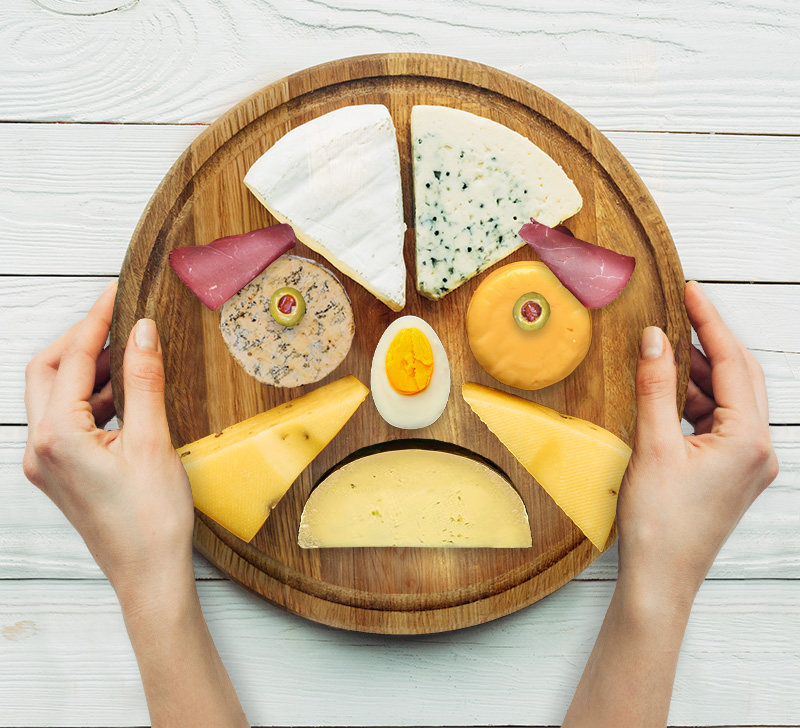Come to Cheeses
I’m sure that everyone has a list of foods that offended them when they were children, but that they enjoy — or even crave — as adults. Mine includes fish, liver, olives, horseradish, and (of course) alcoholic beverages. But way beyond any other item on the scale of repulsiveness was cheese. Cheese — any sort of cheese — was simply disgusting. Even the sound of the word, with its harsh initial consonant followed by a long e-e-e sound that made your face sneer when you said it, was off-putting. Having heard a bit about the process by which cheese was made — which apparently involved curdled milk, bacteria, and juice from a cow’s stomach — did nothing to stimulate my appetite for it.
Whenever I was mistakenly served a cheeseburger rather than a hamburger, I wouldn’t let it anywhere near my face until I’d picked off every bit of melty cheese. On those very rare occasions when my family had takeout pizza for dinner, I refused to eat it. Pizza, after all, was pretty much just a delivery mechanism for cheese.
It wasn’t until late in my senior year of high school that I was cured of this affliction. I was out with a bunch of drama-club friends who decided to go out for pizza, and as a captive in the same car, I had to go with them. I was not invulnerable to peer pressure, and if everyone else was eating pizza, I had to try it too. I did, and it was good. Incredibly good. So good that I cursed myself for all the years of pleasure I’d forgone for not eating pizza. I’ve been making up for that lost time ever since.
Pizza — along with its paesani, calzones and lasagna —turned out to be the gateway drug that led me to appreciate other types of cheese, even those unaccompanied by dough and tomato sauce. I have to admit, however, that my openness to cheese remains limited. I’m still squeamish about soft or smelly cheeses, or cheese made from sheep or goat milk. Processed “cheese food products” such as American cheese, Velveeta, and Cheez Whiz are abhorrent. Any cheese that features mold is out of the question. (My wife, a non-meat-eater, will generously transfer the bacon slices from her Cobb salad onto my plate, but if one of those slices is contaminated by even a molecule of blue cheese dressing, my entire meal can be ruined.)
Still, even my limited gamut of acceptable cheeses includes plenty that are irresistible. Swiss, or Emmental — not to mention its Norwegian cousin, Jarlsberg — is my everyday favorite for snacking. Provolone is the perfect finishing touch for any Italian cold-cut sandwich. Smoked Gouda, especially the aged version known as Old Amsterdam, is addictive.
But the absolute king of cheeses, so far as I’m concerned, is cheddar. Even standard blocks of mass-produced cheddar are OK, but nothing compares to a multi-year-aged, extra-sharp cheddar, with its pungent flavor, crumbly texture, and crunchy crystals. Unfortunately — and for reasons that I’ve been unable to determine — that type of cheddar is almost impossible to get in California. Although it’s a sacrifice that Debra and I knowingly made when we moved from the east coast to the west more than 30 years ago, the absence of extra-sharp cheddar still hurts.
It was a delight, then, to arrive here in London and discover that high-quality cheddar is commonplace. I suppose that it shouldn’t have been a surprise, since the town of Cheddar, where the cheese originated, is only 100 or so miles away. Still, I would never have expected that you could walk into any grocery store and find a variety of cheddars, sliced or in blocks, ranked numerically by level of maturity.
Because we’re here for two months, we prepare many of our meals at home (although it’s hard for me to resist the temptation to have breakfast, lunch, and dinner at one of our several local pubs). Still, even an ordinary lunchtime sandwich becomes a real treat when it includes a slice of tangy, mature cheddar. I don’t know what’s going to happen when we return home to Oakland and once again have to resort to eating Tillamook. I may long for the time when I refused to eat any cheese at all, and therefore had no idea what I was missing.

You now have me questioning whether somebody looks like they’re sneering or smiling when they say “cheese” as a picture is taken.